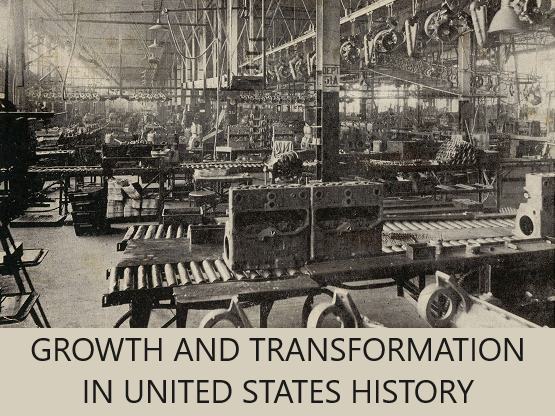Unit VIII: Growth and Transformation |
| www.studenthandouts.com > U.S. History > Growth and Transformation |
| U.S. Growth Books & Films | U.S. Growth Miscellaneous |
| U.S. Growth Maps & Pictures | U.S. Growth Outlines & PPTs |
| U.S. Growth Study Games | U.S. Growth Worksheets |
The late nineteenth century in the United States was marked by profound growth and transformation, driven by a combination of economic, technological, social, and political forces. This period, often referred to as the "Gilded Age" (roughly from the 1870s to the early 1900s), saw the nation undergo significant changes. Here are the key forces that drove U.S. growth and transformation during this era.
 Industrialization: Industrialization was a dominant force in the late nineteenth century. Advances in technology, such as the development of the telegraph, steam engine, and later electricity, fueled the growth of industries like steel, railroads, textiles, and manufacturing. The expansion of factories and the construction of railroads contributed to economic growth and urbanization.
Industrialization: Industrialization was a dominant force in the late nineteenth century. Advances in technology, such as the development of the telegraph, steam engine, and later electricity, fueled the growth of industries like steel, railroads, textiles, and manufacturing. The expansion of factories and the construction of railroads contributed to economic growth and urbanization. Technological Innovation: Innovations like the telephone, typewriter, and electric light bulb revolutionized communication and daily life. Thomas Edison and other inventors played a pivotal role in these advancements. Expansion of Railroads: The completion of transcontinental railroads, such as the First Transcontinental Railroad in 1869, connected the East and West Coasts, facilitating transportation, trade, and westward migration. Railroads also spurred the growth of industries like steel and coal. Urbanization: The late nineteenth century witnessed rapid urbanization as people moved from rural areas to cities in search of job opportunities. Cities like New York, Chicago, and Philadelphia experienced explosive growth, leading to the development of infrastructure, public transportation, and new social challenges. Immigration: Mass immigration from Europe, Asia, and other regions brought a diverse influx of people to the United States. This immigration wave fueled labor markets, contributed to cultural diversity, and led to the growth of immigrant communities in urban areas. Corporate Consolidation and Trusts: Many industries saw the emergence of large corporations and trusts, which concentrated economic power. companies like Standard Oil and U.S. Steel became dominant forces in their respective sectors, leading to concerns about monopolies and antitrust efforts. Labor Movements: The growth of industrialization and the harsh working conditions in factories led to the emergence of labor unions and strikes. The American Federation of Labor (AFL) and the Knights of Labor were prominent labor organizations that advocated for workers' rights and better working conditions. Political Changes: The late nineteenth century was marked by significant political developments. The era saw the rise of political machines in cities and the influence of big business on politics. The Populist Movement emerged as a response to economic inequality and agrarian distress. Westward Expansion and Frontier Closing: The closing of the western frontier was a defining moment in U.S. history. The census of 1890 declared the frontier closed, marking the end of a period of westward expansion. This had significant implications for land settlement and Native American communities. Cultural Shifts: The Gilded Age was also a time of cultural change. It saw the rise of new forms of entertainment, including vaudeville, dime novels, and early cinema. It was also marked by literary movements, such as Realism and Naturalism. Social and Economic Inequalities: Despite economic growth, the Gilded Age was characterized by stark social and economic inequalities. The wealthy elite, often referred to as the "robber barons," accumulated immense fortunes, while many Americans lived in poverty. Changes in Education and Science: The late nineteenth century saw the expansion of education, including the establishment of land-grant colleges and the spread of public education. Scientific discoveries and advancements in fields like medicine and psychology had a significant impact on society. Emergence of Consumer Culture: The development of department stores, mail-order catalogs, and advertising contributed to the growth of consumer culture. People had access to a wider range of goods and products. Government Regulation and Reform: The excesses of the Gilded Age prompted calls for government regulation and reform. Progressive Era reforms, such as the Pure Food and Drug Act and the establishment of the National Park System, aimed to address social and political issues. These forces combined to shape the United States into a rapidly modernizing and industrialized nation. The period was marked by both unprecedented economic growth and deep social disparities, laying the groundwork for future reforms and transformations in the twentieth century. |
| UNIT I: | Early America | UNIT IX: | Discontent and Reform | ||
| UNIT II: | Colonial Period | UNIT X: | War, Prosperity, and Depression | ||
| UNIT III: | American Revolution | UNIT XI: | New Deal and World War II | ||
| UNIT IV: | New National Government | UNIT XII: | Postwar America | ||
| UNIT V: | Westward Expansion | UNIT XIII: | Decades of Change | ||
| UNIT VI: | Sectional Conflict | UNIT XIV: | New Conservatism | ||
| UNIT VII: | Civil War and Reconstruction | UNIT XV: | Into the Twenty-first Century | ||
| UNIT VIII: | Growth and Transformation | UNIT XVI: | Polarization and Deglobalization |
| www.studenthandouts.com > U.S. History > Growth and Transformation |







